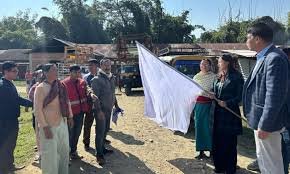By PC Bureau
April 19, 2025
For thousands of international students in the United States, the dream of studying and building a career has collided with a harsh reality: visa revocations. A recent study by the American Immigration Lawyers Association (AILA) reveals that Indian students are disproportionately affected, accounting for 50 percent of reported visa revocation cases under the Trump administration. The report, based on 327 cases, paints a troubling picture of arbitrary terminations, lack of transparency, and severe consequences for students, particularly those on Optional Practical Training (OPT). As the crackdown intensifies, Indian students face financial ruin, emotional distress, and an uncertain future, raising urgent questions about fairness and accountability in U.S. immigration policy.
The Scale of the Crisis
The AILA study highlights a stark reality: of the 327 visa revocation cases examined, half involved Indian students, followed by 14 percent from China. Since January 20, 2025, Immigration and Customs Enforcement (ICE) has terminated 4,736 Student and Exchange Visitor Information System (SEVIS) records, the majority affecting students on F-1 visas. A significant portion of these revocations—50 percent—targeted students on OPT, a program allowing graduates to work in the U.S. for up to three years in their field of study.
For Indian students, who form one of the largest groups of international students in the U.S., the impact is devastating. In 2024, over 200,000 Indian students were enrolled in U.S. institutions, drawn by world-class education and career opportunities. Many invest their families’ life savings to study abroad, with the hope of gaining professional experience through OPT. However, the sudden revocation of their visas has left them stranded, often with no explanation or recourse.
READ: Special Story: Timber Smuggling in Manipur: Assam Rifles Crackdown Exposes Deep-Rooted Illicit Trade
The Human Toll: Stories of Struggle
The consequences of visa revocations extend far beyond legal status. Students face financial ruin, emotional trauma, and disrupted career aspirations. Take the case of Priya Sharma (name changed), a 26-year-old computer science graduate from Hyderabad. After securing a job at a Silicon Valley tech firm through OPT, Priya received an email from ICE in February 2025 informing her that her SEVIS record had been terminated. No reason was provided, and her university was not notified. “I was in shock,” she said. “I had no warning, no chance to appeal. I lost my job overnight and now face deportation. My family took loans to send me here.”
According to a policy brief report titled “The Scope of Immigration Enforcement Actions Against International Students”, issued by the American Immigration Lawyers Association (AILA), out of 327 reports of visa revocations and SEVIS terminations, 50 percent of the students were… pic.twitter.com/9amNanonXK
— Maktoob (@MaktoobMedia) April 18, 2025
Priya’s story is not unique. Many students report receiving no notice of their visa termination—7 percent in the AILA study received neither ICE nor university notifications. For those on OPT, the sudden loss of work authorization leads to immediate unemployment, leaving them unable to pay rent, loans, or living expenses. The financial strain is compounded by the high cost of legal representation, which many cannot afford.
Emotionally, the toll is immense. Students describe feelings of shame, isolation, and betrayal. “I worked so hard to follow every rule,” said Arjun Patel (name changed), a 24-year-old engineering graduate from Mumbai. “Now I’m treated like a criminal for a parking ticket from two years ago. I can’t face my parents.” The uncertainty of deportation and the stigma of returning home without a degree or job weigh heavily on students, many of whom face intense familial and societal expectations.
Questionable Justifications and Lack of Transparency
The Trump administration has defended its visa crackdowns, claiming they target students involved in political unrest or other violations. However, the AILA study debunks these assertions. Only two of the 327 students reported any history of political protest. While 86 percent had some interaction with law enforcement, the majority involved minor infractions: 33 percent had cases dismissed, were never charged, or were never prosecuted. Some students were victims of domestic violence, while others had speeding tickets or parking violations—hardly grounds for visa revocation.
READ: Congress, KOHUR and Meitei Slam False Claims in Biren Singh Audio Tape Controversy
The lack of transparency in the process exacerbates the problem. Only 14 percent of affected students, all on OPT, received direct notice from ICE, typically via email informing them of OPT termination. Others discovered their status had been revoked only when their employers flagged issues with work authorization or when they were detained by immigration authorities. The absence of clear communication leaves students in limbo, unable to plan or seek redress.
The AILA report also highlights the inefficiencies of the SEVIS system. Terminations often occur without university involvement, and students have no clear avenue to appeal inaccurate decisions. “The system is opaque and arbitrary,” said AILA spokesperson Sarah Thompson. “Students deserve due process, not sudden deportation for minor or unproven infractions.”
Systemic Issues and Policy Failures
The visa revocation crisis reflects broader issues in U.S. immigration policy under the Trump administration. Since 2025, the administration has intensified scrutiny of international students, citing national security and economic concerns. Policies targeting OPT, H-1B visas, and F-1 status have created a climate of fear, particularly for Indian and Chinese students, who dominate STEM fields critical to the U.S. economy.
READ: Modi–Musk Phone Call Sparks Tesla India Launch Buzz
The reliance on SEVIS terminations as a blunt enforcement tool has drawn criticism. Universities, responsible for maintaining SEVIS records, are often unaware of ICE’s actions, leaving students without institutional support. The lack of an appeals process further compounds the issue. “Students are caught in a bureaucratic nightmare,” said immigration attorney Rajesh Gupta. “They’re punished without evidence and have no way to fight back.”
The economic impact is also significant. International students contribute over $40 billion annually to the U.S. economy, supporting jobs and innovation. Indian students, in particular, drive growth in tech and engineering sectors. Mass visa revocations risk alienating talent and damaging the U.S.’s reputation as a global education hub.
Calls for Reform and Accountability
The AILA study calls for urgent reforms to address the crisis. Key recommendations include:
Increased Transparency: ICE must provide clear reasons for SEVIS terminations and notify both students and universities promptly.
Appeals Process: A formal mechanism for students to challenge inaccurate terminations, without employment gaps or university involvement, is critical.
Oversight and Accountability: Independent audits of ICE’s visa revocation practices to prevent arbitrary decisions.
Support for Affected Students: Legal and financial assistance to help students navigate the fallout of visa terminations.
Advocacy groups and universities are also stepping up. The National Association of Foreign Student Advisers (NAFSA) has urged Congress to investigate ICE’s practices, while student organizations like the Indian American Student Association are mobilizing to provide legal aid and mental health support.
A Fight for Fairness
For Indian students like Priya and Arjun, the future remains uncertain. Some are exploring legal challenges, while others face the painful decision to return home. The AILA study has brought their plight to light, but systemic change is needed to prevent further harm. As the U.S. grapples with immigration policy debates, the stories of these students serve as a reminder of the human cost of blanket enforcement.
The visa revocation crisis is not just a legal issue—it’s a test of the U.S.’s commitment to fairness, diversity, and opportunity. For Indian students, who have long seen America as a land of promise, the stakes could not be higher. Without reform, thousands risk losing their dreams, and the U.S. risks losing the talent that fuels its future.













